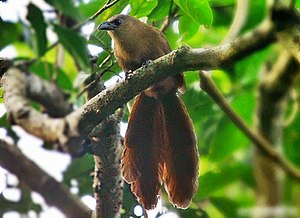Celebeskuckuck
| Celebeskuckuck | ||||||||||||
|---|---|---|---|---|---|---|---|---|---|---|---|---|

Celebes cuckoo ( Centropus celebensis ) |
||||||||||||
| Systematics | ||||||||||||
|
||||||||||||
| Scientific name | ||||||||||||
| Centropus celebensis | ||||||||||||
| Quoy & Gaimard , 1830 |
The Celebeskuckuck ( Centropus celebensis ) is a species of the spur cuckoo ( Centropus ). It occurs in two subspecies on Sulawesi , the Togian Islands and on the Buton and Muna islands .
features
The Celebeskuckuck reaches a length of 42 to 51 cm. The upper head of the adult birds of the nominate form Centropus celebensis celebensis is greyish. The rest of the head and the coat are solid beige-gray with yellow-brown feather shafts. The rest of the top and the wings are reddish brown with a fine purple sheen. The underside is light gray-yellow-brown, the belly and the under tail-coverts are light reddish brown. The stepped tail is solid reddish brown with a purple sheen. The juvenile birds are similar to the adult birds. The plumage is lighter in them, the skull less gray and the tail feathers narrower. The iris is red in adult birds and gray in juvenile birds. The beak is black with a horn-brown to yellowish white tip. In juvenile birds, the lower bill and the tip of the upper bill are light-colored. The feet are black. The subspecies Centropus celebensis rufescens is more reddish brown and often has black reins.
distribution
Centropus celebensis celebensis occurs in North Sulawesi and the Togian Islands . The distribution area of Centropus celebensis rufescens extends to South Sulawesi, Buton , Labuan Blanda and on the island of Muna .
habitat
The habitat includes primary and secondary lowland and hillside forests, but also forest edges and scrubland at altitudes of up to 1,100 m. It is less common in mangrove forests. It can also be observed in disturbed primary forests, in palm vegetation, in the forest savannah, in forests on ultra- basic rock and in cultivated regions with settlements.
Way of life
The Celebesuckuck is monogamous and usually goes foraging in pairs. But you can also observe it in association with great-billed cuckoos and crested monkeys . It prefers the thick vegetation and is therefore difficult to observe. Like a malkoha , he climbs through the lianas and the thick leaves. He can move very quickly on the forest floor. There is little information about its breeding behavior. A female with enlarged ovaries was observed in February. The flat, open nest resembles a pigeon's nest and is made of bush wood in trees. The food of the Celebes cuckoo includes jumping terrors , beetles , caterpillars, spiders and fruits such as nutmegs .
Status and exposure
The Celebeskuckuck is classified by BirdLife International as "not endangered" ( least concern ). It is rare in most of Sulawesi and on the neighboring islands, but is moderately common locally. It is locally common in Dumoga-Bone National Park. It seems to have a great tolerance for living space, as it even lives in cultivated areas. However, the rattan extraction in its range represents a serious threat to the population.
literature
- Johannes Erritzøe , Clive F. Mann, Frederik Brammer, Richard A. Fuller: Cuckoos of the World (Helm Identification Guides) . Christopher Helm Publishers Ltd, 2012. ISBN 978-071-366-034-0 . Pp. 160-161
Web links
- Centropus celebensis inthe IUCN Red List of Threatened Species 2013.1. Listed by: BirdLife International, 2012. Retrieved September 28, 2013.
- BirdLife International: Species Factsheet - Bay Coucal ( Centropus celebensis ) . Retrieved September 28, 2013.
- Videos, photos and sound recordings of Bay Coucal (Centropus celebensis) in the Internet Bird Collection
- Celebeskuckuck ( Centropus celebensis ) at Avibase; Retrieved September 28, 2013.
- Centropus celebensis in the Integrated Taxonomic Information System (ITIS). Retrieved September 28, 2013.
- xeno-canto: sound recordings - Bay Coucal ( Centropus celebensis )